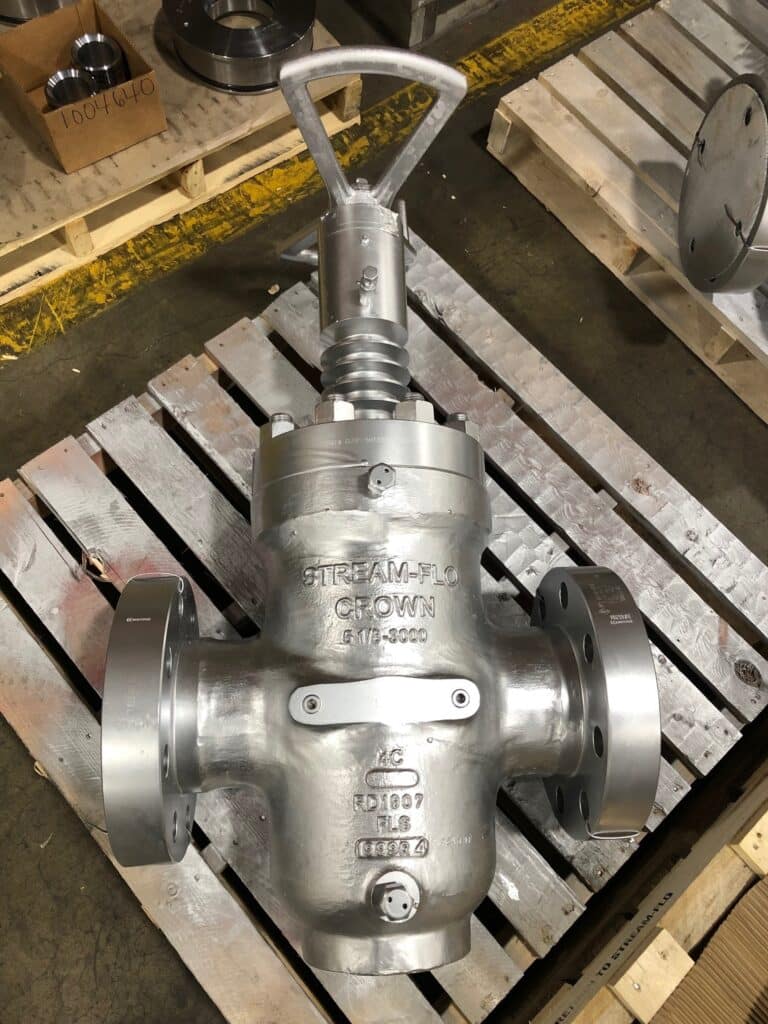Expanding gate valve dramatically reduces risk of failure due to ice and steam
It was an industry-wide issue that had caused serious problems over the years: fluid getting trapped in a valve then freezing and expanding as temperatures in colder regions — like Canada’s oilsands — dipped well below 0°C. The ensuing consequences that sometimes happened due to pressure inside the valve rising beyond rated limits where the bonnet and body meet, could only be classified as one thing — a catastrophic failure.
“There’s nothing on Earth that can contain ice,” said Stream-Flo VP of Technology Keith Farquharson recently, the one tasked with overseeing the project that would eventually come up with a solution for the problem.
“We went through a bunch of testing,” he says. “Immediately you start testing in the lab to reproduce this failure.”
The failure Farquharson is talking about led to an Enform Alert being issued. And it was an alert that was specific to SAGD (steam-assisted gravity drainage) applications. Which are very common where heavy oil and bitumen are found, such as Fort McMurray.
“Most of our equipment in Fort McMurray is 2,000 psi rated,” said Farquharson. “If you take a valve full of water or grease and start heating it up, by the time you get to about 400-500°F, you’re well over 10,000 psi.
“Now if you fill it full of water and freeze it — well over 30,000 psi is what you can get to, if you can restrain it.”
So what Farquharson and the rest of the Stream-Flo team did was find a way to let ice and steam release inside the line as opposed to in the body. In essence, they redirected the force that was generated due to either extreme temperature so it had somewhere to go. Which wasn’t as simple as it may sound.

The answer to an industry-wide issue. The Crown Model AV Gate Valve utilizes an expanding vented gate to provide a positive mechanical seal in which heat, pressure variations, and vibrations will not affect the seal.
“It took us several years to figure out exactly how to do that,” said Farquharson. “That included input from customers, our valve repair team, our field service guys, our R&D team, and engineering department. It was the definition of a total team effort.”
One of the reasons the project took so long is because there was no “Start from scratch” option due to how many of these valves were already out in the field says Farquharson.
That meant they had to find a way to utilize the valves, bodies, and parts that were already out there.
“If a customer has thousands of these affected valves out in the field, we can’t tell them they have to buy a new valve,” explained Farquharson. “We’ve got to be able to repair it and bring it up to today’s standards.”
One of the key departments that was tapped early on to help with the project was Stream-Flo’s customer property/reconditioning unit, with coordinator Dean Ternovoy leading the way. Using Ternovoy’s extensive valve reconditioning knowledge, Farquharson and his team would run possible fixes by him to see if they were feasible from a repair standpoint.
Once something was deemed possible, Farquharson says manufacturing had to be brought in to ensure the economic viability of the solution. All the while listening to customers to make sure they were comfortable with the proposed plan.
“What we wanted to do was offer our customers an opportunity to salvage the body and most of the internals and provide a repair path to the new version of the valve.”
Which is exactly what Farquharson and the rest of the team assigned to the expanding gate valve project did in developing the AV model. With great results, as Stream-Flo Heavy Oil Operations Manager Geoff Gibson — the one tasked with interfacing in the field with customers since the project started — explains.
“To date, we haven’t had a single AV valve returned due to it not working properly,” he says. “There’s obviously a lot of relief. The way the stem packing works in these valves makes them much easier to operate as well. That’s a huge thing from a field perspective, these guys that are spinning the valve handles, were quite happy to see that.”
After the AV fix was unveiled, Gibson said he was busy bringing customers and operators up to speed about it and its ability to address the longstanding issue end users in Canada’s oilsands had been facing.
So too was Stream-Flo Technical Sales Representative Joel Colucci, who presented the new design in 2019 at the Society of Petroleum Engineers Thermal Well Integrity and Production Symposium in Banff after the valve had completed a successful year-long trial.
“I remember being up on stage and the questions were coming in fast and furious,” recalls Colucci. “Everyone was all over this topic because every customer out there was having the same issues. Everyone was very intrigued by the results and very interested by the products we have to offer.”
Those products, such as the AV gate valve, are only possible because of the expertise contained within Stream-Flo, Colucci adds.
“That’s what sets us apart from our competitors,” he says. “We have the engineering power and we have the facilities to do all the R&D and testing required. We have dedicated valve engineers where all they deal with is valves — we make our own Crown gate valves whereas most of our competitors just outsource valves. Customers are having these issues and we have the resources to help them out.”
Stream-Flo Gate Valve Engineering Manager Tom Gust is one such resource. Integral to the AV project, he takes a demure stance by saying he was just “Doing his job” when asked what role he played in the solution.
“It really was a combined effort between service, manufacturing, the customer, and us (engineering),” said Gust. “You’re always looking for a way to improve things. There isn’t any design or item that’s been created that can’t be improved. It’s just a continual process.
“With any evolution of a design you want to maintain as much backward compatibility as you can so that you’re not stranding parts as you go forward. You’re not really trying to revolutionize the world as much as just evolve it, so that you take the next step that serves everybody, and that includes repairs for the field so if someone’s got a previous model, they can rework it and bring it forward.”
Since many SAGD producers viewed the long-standing issue as a significant enough risk to warrant either replacing or repairing all their current valves in operation, the cost-effective repair path Stream-Flo engineered has been gaining high praise and a lot of interest. So much so that the new challenge Stream-Flo faces is one of keeping up with managing retrofit requests from their thermal customers.
“We’ve only just started scratching the surface, there’s decades worth of previous valves out there,” says Gibson. “Stream-Flo didn’t invent the model A valve. It’s been a long time since any major upgrade had been made to the design and I think this is an important one. It’s a major step in the right direction and an industry first and one that will become standard.”
To see all our gate valve options, click the button below.
